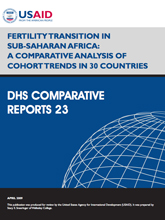- FEATURED

(1) Fertility
(2) Fertility Preference
(3) Other Proximate Determinants of Fertility
Extensive data on fertility and fertility preferences are available on STATcompiler. Compare among countries and analyze trends over time.
Why collect data on fertility and fertility preferences?
Information on current and total fertility is essential in monitoring population growth and developing policies and programs. Birth intervals are important because short intervals increase the risk of childhood mortality. A mother's age during childbearing – whether too young or too old – can increase the risk to the health of the mother and the child. Information on fertility preferences provides family planning programs with an understanding of the potential ‘demand’ for fertility control in a given population.
How does DHS collect data on fertility and fertility preferences?
Data on fertility are collected in several ways. First, each woman is asked the number of sons and daughters who live with her, the number who live elsewhere, and the number who were born alive and later died. Next, a complete history of all the woman’s births is obtained, including the name, sex, month and year of birth, age, and survival status for each of the births. For living children, a question is asked about whether the child was living in the household or away. For dead children, the age at death is recorded. Finally, information is collected on whether a woman was pregnant at the time of the survey.
To collect data on fertility preferences, women and men are asked a series of questions including their desire to have another child, the length of time they would like to wait before having another child, and what they would consider to be the ideal number of children.
DHS indicators about fertility and fertility preferences
Current Fertility
- Age-specific and total fertility rates
- General fertility rate
- Crude birth rate
- Fertility by background characteristics
- Mean number of children ever born to women aged 40-49
- Fertility trends
- Fertility by marital duration
- Children ever born and living
- Birth intervals by background characteristics
- Age at first birth
- Teenage pregnancy and motherhood by background characteristics
- Birth order
Fertility Preferences
- Fertility preference by number of living children
- Fertility preferences by age
- Desire to limit childbearing
- Unmet need for family planning services
- Ideal and actual number of children
- Mean ideal number of children by background characteristics
Other Proximate Determinants of Fertility
- Current marital status
- Sexual relationships of non-married women
- Number of co-wives (women) / Number of wives (men)
- Age at first marriage
- Age at first sexual intercourse
- Recent sexual activity
- Median and mean durations for postpartum amenorrhea, abstinence and insusceptibility
- Prevalence/incidence mean for postpartum amenorrhea, abstinence and insusceptibility
